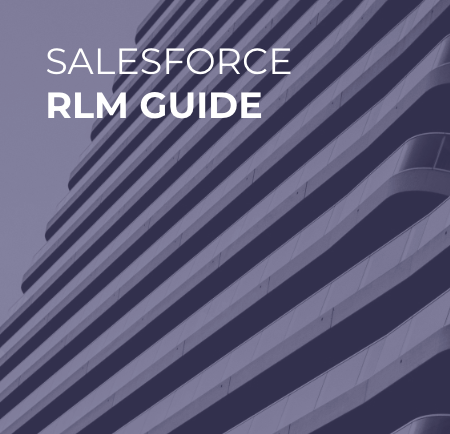
What is Salesforce Revenue Lifecycle Management?As businesses navigate the complexities of modern sales and revenue operations, the need for a comprehensive and integrated solution becomes essential. Salesforce Revenue Lifecycle Management (RLM) is designed to meet this need by providing a holistic approach to managing the entire revenue lifecycle. In this blog, we will explore what Salesforce RLM is, its key components, and the benefits it brings to organizations.
Understanding Salesforce Revenue Lifecycle Management
Salesforce Revenue Lifecycle Management (RLM) is an end-to-end solution that manages all aspects of a company’s revenue operations—from initial opportunity creation to revenue recognition and renewal management. It integrates various functionalities into one cohesive system, thereby streamlining processes, improving accuracy, and driving revenue growth.
Key Components of Salesforce RLM
Opportunity Management
Opportunity management is the starting point of the revenue lifecycle. Salesforce RLM allows sales teams to effectively track and manage opportunities through every stage of the sales pipeline.
- Opportunity Tracking: Capture and track opportunities, ensuring no opportunity is missed.
- Pipeline Visibility: Provides a clear view of the sales pipeline, facilitating better forecasting and decision-making.
- Custom Workflows: Configurable workflows to align with unique sales processes.
Configure, Price, Quote (CPQ)
CPQ capabilities within Salesforce RLM streamline the creation of accurate quotes. This feature ensures that complex product configurations and pricing rules are applied consistently.
- Automated Quotes: Generates precise quotes quickly, reducing the time to close deals.
- Price Optimization: Ensures optimal pricing strategies are utilized.
- Product Bundling: Allows for the bundling of products and services to enhance sales offerings.
Order and Contract Management
Managing orders and contracts is simplified with Salesforce RLM, ensuring seamless transitions from quotes to fulfilled orders.
- Order Automation: Automated order processing reduces manual errors and accelerates order fulfillment.
- Contract Lifecycle Management: Handles contract creation, execution, and renewal efficiently.
- Renewal Management: Automates renewals to minimize revenue leakage.
Billing and Invoicing
Salesforce RLM includes advanced billing functionalities to handle various billing scenarios and to generate accurate invoices.
- Subscription Billing: Manages recurring billing for subscription-based models.
- Usage-Based Billing: Supports billing based on usage, providing flexibility in billing arrangements.
- Invoice Generation: Automated invoice generation ensures timely and accurate billing.
Revenue Recognition
To comply with accounting standards such as ASC 606 and IFRS 15, Salesforce RLM automates the revenue recognition process, ensuring adherence to regulations.
- Automated Revenue Allocation: Allocates revenue based on predefined rules.
- Compliance: Ensures compliance with industry standards and government regulations.
- Audit Readiness: Maintains detailed audit trails for financial transparency.
Analytics and Reporting
Salesforce RLM comes equipped with robust analytics and reporting tools to provide insights into the entire revenue lifecycle.
- Dashboards: Customizable dashboards offer real-time insights into revenue performance.
- Predictive Analytics: Utilize AI and machine learning to forecast revenue trends.
- Detailed Reports: Generate comprehensive reports on key metrics and KPIs.
Benefits of Salesforce Revenue Lifecycle Management
Implementing Salesforce RLM brings numerous benefits to organizations, including:
- Enhanced Efficiency: Automating and integrating revenue-related processes reduces manual effort and errors, leading to increased operational efficiency.
- Improved Accuracy: Accurate quotes, invoices, and revenue recognition practices ensure that financials are always in check, mitigating risks associated with revenue management.
- Better Customer Experience: With streamlined processes, customers receive timely and accurate quotes, invoices, and renewals, leading to improved satisfaction and loyalty.
- Scalability: Salesforce RLM is designed to scale with your business, accommodating growth and evolving business needs without compromising efficiency.
- Comprehensive Compliance: Automated compliance with accounting standards and regulations ensures that your revenue management practices are always audit-ready.
Why Choose CloudMasonry for Salesforce RLM?
Implementing Salesforce RLM effectively can be a complex task. That’s where CloudMasonry comes in. As a leading Salesforce consulting partner, we specialize in customizing and implementing Salesforce RLM solutions tailored to your business requirements.
If you’re interested in learning more about the key features of Salesforce RLM, we’ve written this post for you.
As businesses navigate the complexities of modern sales and revenue operations, the need for a comprehensive and integrated solution becomes essential. Salesforce Revenue Lifecycle Management (RLM) is designed to meet this need by providing a holistic approach to managing the entire revenue lifecycle. In this blog, we will explore what Salesforce RLM is, its key components, and the benefits it brings to organizations.
Understanding Salesforce Revenue Lifecycle Management
Salesforce Revenue Lifecycle Management (RLM) is an end-to-end solution that manages all aspects of a company’s revenue operations—from initial opportunity creation to revenue recognition and renewal management. It integrates various functionalities into one cohesive system, thereby streamlining processes, improving accuracy, and driving revenue growth.
Key Components of Salesforce RLM
Opportunity Management
Opportunity management is the starting point of the revenue lifecycle. Salesforce RLM allows sales teams to effectively track and manage opportunities through every stage of the sales pipeline.
- Opportunity Tracking: Capture and track opportunities, ensuring no opportunity is missed.
- Pipeline Visibility: Provides a clear view of the sales pipeline, facilitating better forecasting and decision-making.
- Custom Workflows: Configurable workflows to align with unique sales processes.
Configure, Price, Quote (CPQ)
CPQ capabilities within Salesforce RLM streamline the creation of accurate quotes. This feature ensures that complex product configurations and pricing rules are applied consistently.
- Automated Quotes: Generates precise quotes quickly, reducing the time to close deals.
- Price Optimization: Ensures optimal pricing strategies are utilized.
- Product Bundling: Allows for the bundling of products and services to enhance sales offerings.
Order and Contract Management
Managing orders and contracts is simplified with Salesforce RLM, ensuring seamless transitions from quotes to fulfilled orders.
- Order Automation: Automated order processing reduces manual errors and accelerates order fulfillment.
- Contract Lifecycle Management: Handles contract creation, execution, and renewal efficiently.
- Renewal Management: Automates renewals to minimize revenue leakage.
Billing and Invoicing
Salesforce RLM includes advanced billing functionalities to handle various billing scenarios and to generate accurate invoices.
- Subscription Billing: Manages recurring billing for subscription-based models.
- Usage-Based Billing: Supports billing based on usage, providing flexibility in billing arrangements.
- Invoice Generation: Automated invoice generation ensures timely and accurate billing.
Revenue Recognition
To comply with accounting standards such as ASC 606 and IFRS 15, Salesforce RLM automates the revenue recognition process, ensuring adherence to regulations.
- Automated Revenue Allocation: Allocates revenue based on predefined rules.
- Compliance: Ensures compliance with industry standards and government regulations.
- Audit Readiness: Maintains detailed audit trails for financial transparency.
Analytics and Reporting
Salesforce RLM comes equipped with robust analytics and reporting tools to provide insights into the entire revenue lifecycle.
- Dashboards: Customizable dashboards offer real-time insights into revenue performance.
- Predictive Analytics: Utilize AI and machine learning to forecast revenue trends.
- Detailed Reports: Generate comprehensive reports on key metrics and KPIs.
Benefits of Salesforce Revenue Lifecycle Management
Implementing Salesforce RLM brings numerous benefits to organizations, including:
- Enhanced Efficiency: Automating and integrating revenue-related processes reduces manual effort and errors, leading to increased operational efficiency.
- Improved Accuracy: Accurate quotes, invoices, and revenue recognition practices ensure that financials are always in check, mitigating risks associated with revenue management.
- Better Customer Experience: With streamlined processes, customers receive timely and accurate quotes, invoices, and renewals, leading to improved satisfaction and loyalty.
- Scalability: Salesforce RLM is designed to scale with your business, accommodating growth and evolving business needs without compromising efficiency.
- Comprehensive Compliance: Automated compliance with accounting standards and regulations ensures that your revenue management practices are always audit-ready.
Why Choose CloudMasonry for Salesforce RLM?
Implementing Salesforce RLM effectively can be a complex task. That’s where CloudMasonry comes in. As a leading Salesforce consulting partner, we specialize in customizing and implementing Salesforce RLM solutions tailored to your business requirements.
If you’re interested in learning more about the key features of Salesforce RLM, we’ve written this post for you.
